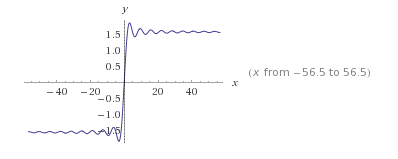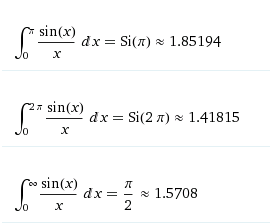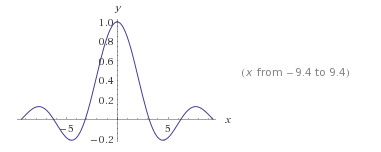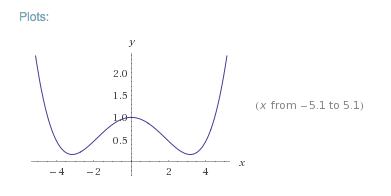A longer look at the Si(x) function
Sinx/x can’t be integrated into an elementary function – instead we define:

Where Si(x) is a special function. This may sound strange – but we already come across another similar case with the integral of 1/x. In this case we define the integral of 1/x as ln(x). ln(x) is a function with its own graph and I can use it to work out definite integrals of 1/x. For example the integral of 1/x from 1 to 5 will be ln(5) – ln(1) = ln(5).
The graph of Si(x) looks like this:

Or, on a larger scale:

You can see that it is symmetrical about the y axis, has an oscillating motion and as x gets large approaches a limit. In fact this limit is pi/2.
Because Si(0) = 0, you can write the following integrals as:

How to integrate sinx/x ?
It’s all very well to define a new function – and say that this is the integral of sinx/x – but how was this function generated in the first place?
Well, one way to integrate difficult functions is to use Taylor and Maclaurin expansions. For example the Maclaurin expansion of sinx/x for values near x=0 is:

This means that in the domain close to x = 0, the function sinx/x behaves in a similar way to the polynomial above. The last part of this expression O( ) just means everything else in this expansion will be x^6 or greater.
Graph of sinx/x

Graph of 1 – x^2/6 + x^4/120

In the region close to x=0 these functions behave in a very similar manner (this would be easier to see with similar scales so let’s look on a GDC):
So for the region above (x between 0 and 2) the 2 graphs are virtually indistinguishable.
Therefore if we want to integrate sinx/x for values close to 0 we can just integrate our new function 1 – x^2/6 + x^4/120 and get a good approximation.
Let’s try how accurate this is. We can use Wolfram Alpha to tell us that:

and let’s use Wolfram to work out the integral as well:

Our approximation is accurate to 3 dp, 1.371 in both cases. If we wanted greater accuracy we would simply use more terms in the Maclaurin expansion.
So, by using the Maclaurin expansion for terms near x = 0 and the Taylor expansion for terms near x = a we can build up information as to the values of the Si(x) function.
IB teacher? Please visit my new site http://www.intermathematics.com ! Hundreds of IB worksheets, unit tests, mock exams, treasure hunt activities, paper 3 activities, coursework support and more. Take some time to explore!
Are you a current IB student or IB teacher? Do you want to learn the tips and tricks to produce excellent Mathematics coursework? Check out my new IA Course in the menu!


May I know what is the significance of Si(x) Sine integral function, How it can be related to the gibbs phenomenon?
Thanks in advance,
Dharmateja.